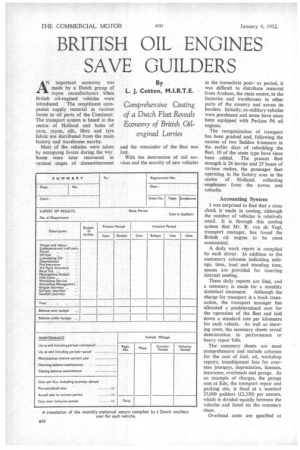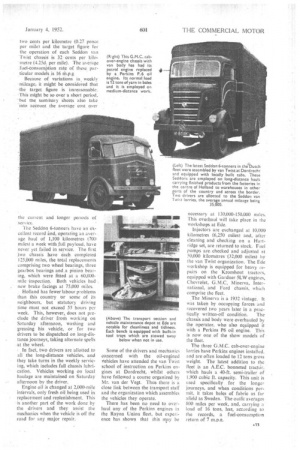BRITISH OIL ENGINES SAVE GUILDERS
Page 50

Page 51

If you've noticed an error in this article please click here to report it so we can fix it.
Comprehensive Costing of a Dutch Fleet Reveals Economy of British Oilengined Lorries
By L. J. Cotton, M.I.R.T.E. AN important economy was made by a Dutch group of rayon manufacturers when British oil-engined vehicles were introduced. The constituent companies supply material in various forms to all parts of the Continent. The transport system is based in the centre of Holland and bales of yarn, rayon, silk, fibre and tyre fabric are distributed from the main factory and warehouse nearby.
Most of the vehicles were taken by occupying forces during the war. Some were later recovered in various stages of dismemberment and the remainder of the fleet was lost.
With the destruction of rail services and the scarcity of new vehicles in the immediate post-'.'ar period, it was difficult to distribute material from Arnhem, the main centre, to the factories and warehouses in other parts of the country and across its borders. Initially, ex-military vehicles were purchased and some have since been equipped with Perkins P6 off engines.
The reorganization of transport has been gradual and, following the success of two Seddon 6-tonners in the earlier days of rebuilding the fleet, 10 of the same type have since been added. The present fleet strength is 26 lorries and 25 buses of various makes, the passenger fleet operating in the factory area in the centre of Holland, collecting employees from the towns and suburbs.
Accounting System I was surprised to find that a close check is made in costing, although the number of vehicles is relatively small. It is through this costing system that Mr. It van de Vegt, transport manager, has found the British oil engine to be most economical.
A daily work report is compiled by each driver. In addition to the customary columns indicating miteage, time, load and standing time, spaces are provided for inserting internal costing.
These daily reports are filed, and a summary is made for a monthly statistical statement. Although the charge for transport is a book transaction, the transport manager has allocated a predetermined sum for the operation of the fleet and laid down a standard rate per kilometre. for each vehicle. As well as showing costs, the summary sheets reveal deterioration in performance or heavy repair bills.
The summary sheets are most comprehensive and include columns for the cost of fuel, oil, workshop repairs, transhipment fees for overseas journeys, depreciation, licences, insurance, overheads and garage. As an example of charges, the garage rent at Ede, the transport repair and parking site, is fixed at a nominal 25,000 guilders (£2,350) per annum. which is divided equally between the vehicles and listed on the summary sheet.
Overhead costs are specified at
two cents per kilometre (0.27 pence per mile) and the target figure for the operation of each Seddon van Twist chassis is 32 cents per kilo:metre (4.25d: per mile). The average fuel-consumption rate of these particular models Is 16 M.p.g
Because of variations in weekly mileage; it might be cemsidered that the target figure is unreasonable. This might be so over a short period, but the stimenary Sheets alSo take into account the average cost over the current and longer periods of service.
The Seddon 6-tonnes have an eXcellent record and, operating an average haul of 1,100 kilometres (700 miles) a week with full payload, have never yet failed in service. The first two chassis have each completed 12,5,000 miles, the total replacements comprising two wheel bearings, three gearbox bearings and.a pinion bearing, which were fitted at a 60,000mile inspection. Both vehicles had new brake facings at 75,000 miles.
Holland has fewer labour problems than this country or some of its neighbours, but statutory driving time must not exceed 55 hours tv....r week. This, however, does not preclude the driver from working on Saturday afternoon, washing and -greasing his vehicle, or for two drivers to be dispatched on long-distance journeys, taking alternate spells at the wheel.
7 In fact, two drivers are allotted to all the long-distance vehicles, and they take turns in the weekly servicing, which includes full chassis lubrication. Vehicles working on local haulage are maintained on Saturday afternoon by the driver.
Engine oil is changed at 2.000-mile intervals, only fresh oil being used in replacement and replenishment. This is another part of the work done by the drivers and they assist the mechanics when the vehicle is off the road for any major repair, Some of the drivers and mechanics concerned with the oil-engined vehicles have attended the van Twist school of instruction on Perkins engines at Dordrecht, whilst others have followed a course organized by Mr. van der Vegt. Thus there is a close link between the transport staff and the organization which assembles the vehicles they operate.
There has been no need to overhaul any of the Perkins engines in the Rayon Union fleet, but experience has shown that this !nay be
necessary at 130,000-150,000 miles. This overhaul will take place in the workshops at Ede.
Injectors are exchanged at 10,000 kilometres (6,250 miles) and, after cleaning and checking on a Hartridge set, are returned to stock. Fuel pumps are. checked and adjusted at 50,000 kilometres (32,000 miles) by the van Twist organization. The Ede workshop is equipped for heavy repairs on the Krornhout tractors, equipped with Gardner5-LW engines, Chevrolet, G.M.C, Minerva, International, and Ford chassis, which comprise the fleet.
The Minerva is a 1932 Vintage, It was taken by occupying forces and recovered two years later in a prae tically written-off condition. The chassis and body were overhauled by the operator, who also equipped it with a Perkins P6 oil engine. This is now one of the show models of the fleet.
The three G.M.C. cab-over-engine lorries have Perkins engines installed, and are often loaded to 12 tons gross weight. The latest addition to the fleet is an A.E.C. bonneted tractor. which hauls a 40-ft. semi-trailer of 1,900 cubic ft. capacity. This unit is used specifically for the longer journeys, and when conditions permit, it takes bales of fabric as far afield as Sweden. The outfit averages 800 miles per week, and, carrying a load of 16 tons, has, according to the records, a fuel-consumption return of 7 m.p.g.




















































































